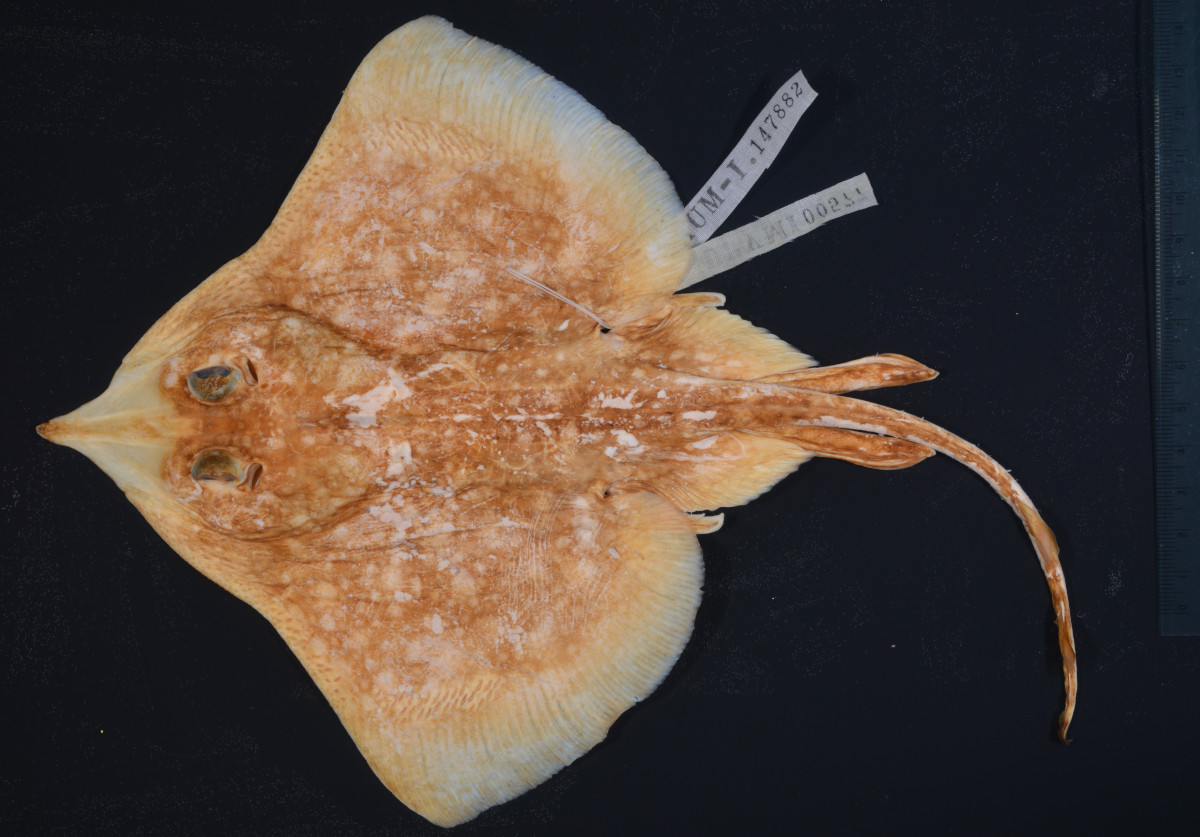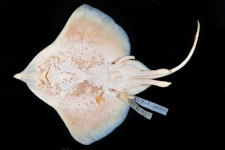Okamejei panayensis
Misawa, Babaran & Motomura, 2022
Classification: Elasmobranchii Rajiformes Rajidae
Reference of the original description
Okamejei panayensis sp. nov., a new skate (Rajiformes: Rajidae) from the Philippines. Ichthyological Research, 70, 161–176
Okamejei panayensis sp. nov., a new skate (Rajiformes: Rajidae) from the Philippines. Ichthyological Research, 70, 161–176
Description :
Citation: Okamejei panayensis Misawa, Babaran & Motomura, 2022: In: Database of modern sharks, rays and chimaeras, www.shark-references.com, World Wide Web electronic publication, Version 12/2025
Please send your images of "Okamejei panayensis" to info@shark-references.com

Okamejei panayensis Misawa & Babaran & Motomura, 2022, holotype, KAUM–I. 147882, 304 mm TL, adult male, (fresh), dorsal view © Ryo Misawa

Okamejei panayensis Misawa & Babaran & Motomura, 2022, holotype, KAUM–I. 147882, 304 mm TL, adult male, (fresh), dorsal view © Ryo Misawa
Common names
 Philippine Skate
Philippine Skate
 Philippine Skate
Philippine Skate
Short Description
Original diagnosis of Misawa, Babaran & Motomura, 2022 [30802]: Okamejei panayensis sp. nov. can be distinguished from congeners by the following combination of characters: tail moderately long, slender and weakly tapering posteriorly, length 51.0% of TL; first dorsal fin (D1) origin to tail tip 21.2% of TL; interdorsal space rather short, distance 67.0% of D1 base length; caudal-fin base length moderate, 1.3 times D1 base length; snout rather short, moderately acute and pointed, preorbital snout length 13.7% of TL, preoral snout length 14.3% of TL, prenarial snout length 11.3% of TL; dorsal head length 20.7% of TL, ventral head length 28.6% of TL; orbits and eyeballs large, orbit diameter 1.3 times interorbital width, eyeball length (horizontal diameter) 1.2 times interorbital width; tail thorns distinct, three rows in adult male; single nuchal thorn; trunk vertebrae 28, predorsal tail vertebrae 43; dorsal surface of disc pale brown, margin yellowish to pale brown; numerous yellowish spots and black flecks sparsely scattered on dorsal disc, but not forming patches; no ocellated markings on dorsal disc; snout area translucent; ventral surface of disc broadly white, margin pale brown, darkly pigmented at pectoral-fin bases, posterior insertions of pectoral fins, nasal curtain, around cloaca, and sensory pore openings; ventral disc sensory pores in a “W-shaped” distribution pattern, absent on abdominal region and near pelvic-fin base; clasper with external boss, cleft, funnel, pseudorhipidion, rhipidion, shield, spike, sentinel, and terminal bridge; clasper skeleton with three dorsal terminal cartilages, single ventral terminal cartilage, two accessory terminal cartilages (accessory terminal 1 “Y-shaped”); mature size small, adult male ca. 30 cm TL.
Original diagnosis of Misawa, Babaran & Motomura, 2022 [30802]: Okamejei panayensis sp. nov. can be distinguished from congeners by the following combination of characters: tail moderately long, slender and weakly tapering posteriorly, length 51.0% of TL; first dorsal fin (D1) origin to tail tip 21.2% of TL; interdorsal space rather short, distance 67.0% of D1 base length; caudal-fin base length moderate, 1.3 times D1 base length; snout rather short, moderately acute and pointed, preorbital snout length 13.7% of TL, preoral snout length 14.3% of TL, prenarial snout length 11.3% of TL; dorsal head length 20.7% of TL, ventral head length 28.6% of TL; orbits and eyeballs large, orbit diameter 1.3 times interorbital width, eyeball length (horizontal diameter) 1.2 times interorbital width; tail thorns distinct, three rows in adult male; single nuchal thorn; trunk vertebrae 28, predorsal tail vertebrae 43; dorsal surface of disc pale brown, margin yellowish to pale brown; numerous yellowish spots and black flecks sparsely scattered on dorsal disc, but not forming patches; no ocellated markings on dorsal disc; snout area translucent; ventral surface of disc broadly white, margin pale brown, darkly pigmented at pectoral-fin bases, posterior insertions of pectoral fins, nasal curtain, around cloaca, and sensory pore openings; ventral disc sensory pores in a “W-shaped” distribution pattern, absent on abdominal region and near pelvic-fin base; clasper with external boss, cleft, funnel, pseudorhipidion, rhipidion, shield, spike, sentinel, and terminal bridge; clasper skeleton with three dorsal terminal cartilages, single ventral terminal cartilage, two accessory terminal cartilages (accessory terminal 1 “Y-shaped”); mature size small, adult male ca. 30 cm TL.
Distribution
off Iloilo, Panay Island, Philippines, Sulu Sea (only holotype) [30802] Source: www.gbif.org
off Iloilo, Panay Island, Philippines, Sulu Sea (only holotype) [30802] Source: www.gbif.org
Dentition
Anterior tooth rows on both jaws exposed, lateral teeth barely concealed by nasal curtain (Fig. 4a); teeth unicuspid, conical, with strongly pointed cusps, arranged regularly in parallel longitudinal rows, directed obliquely posteriorly; tooth rows in upper jaw 35, lower jaw 34. [30802]
Anterior tooth rows on both jaws exposed, lateral teeth barely concealed by nasal curtain (Fig. 4a); teeth unicuspid, conical, with strongly pointed cusps, arranged regularly in parallel longitudinal rows, directed obliquely posteriorly; tooth rows in upper jaw 35, lower jaw 34. [30802]
Remarks
shark-references Species-ID=16338;
shark-references Species-ID=16338;


















